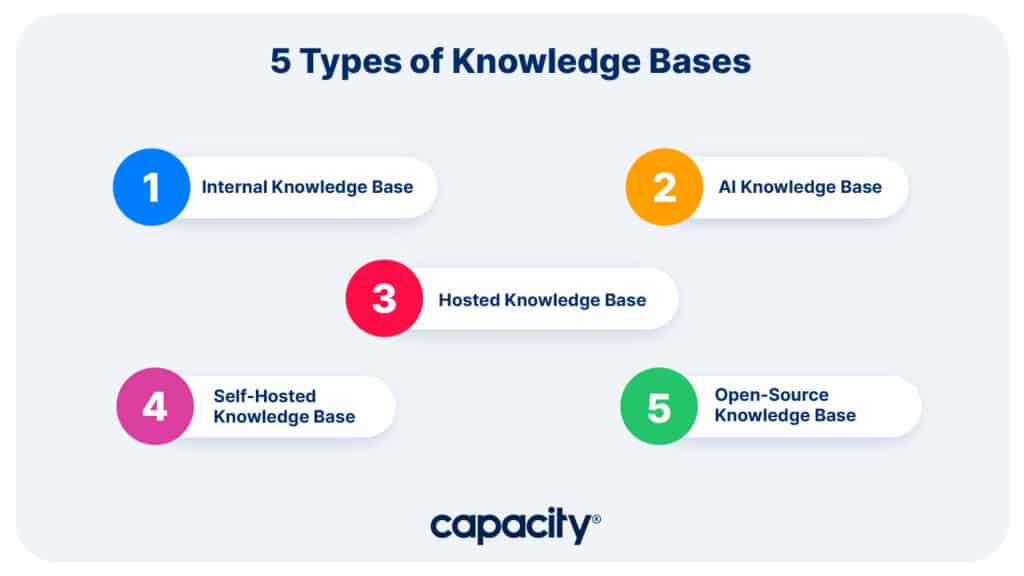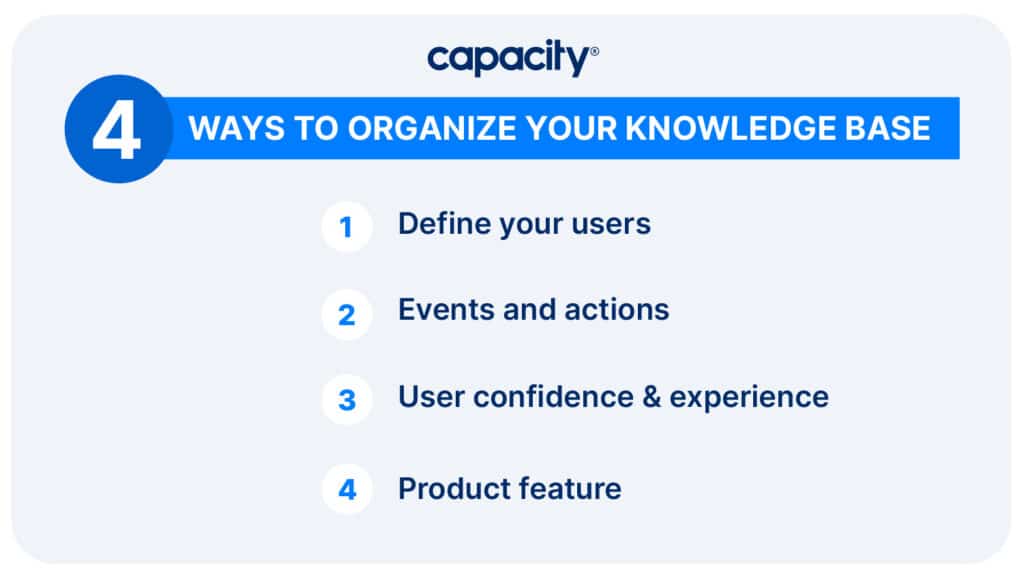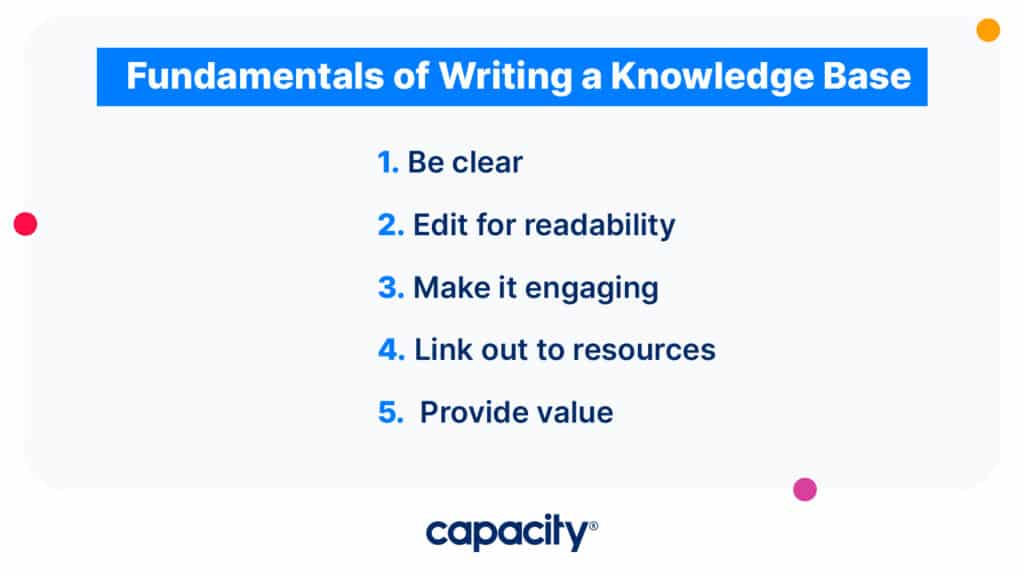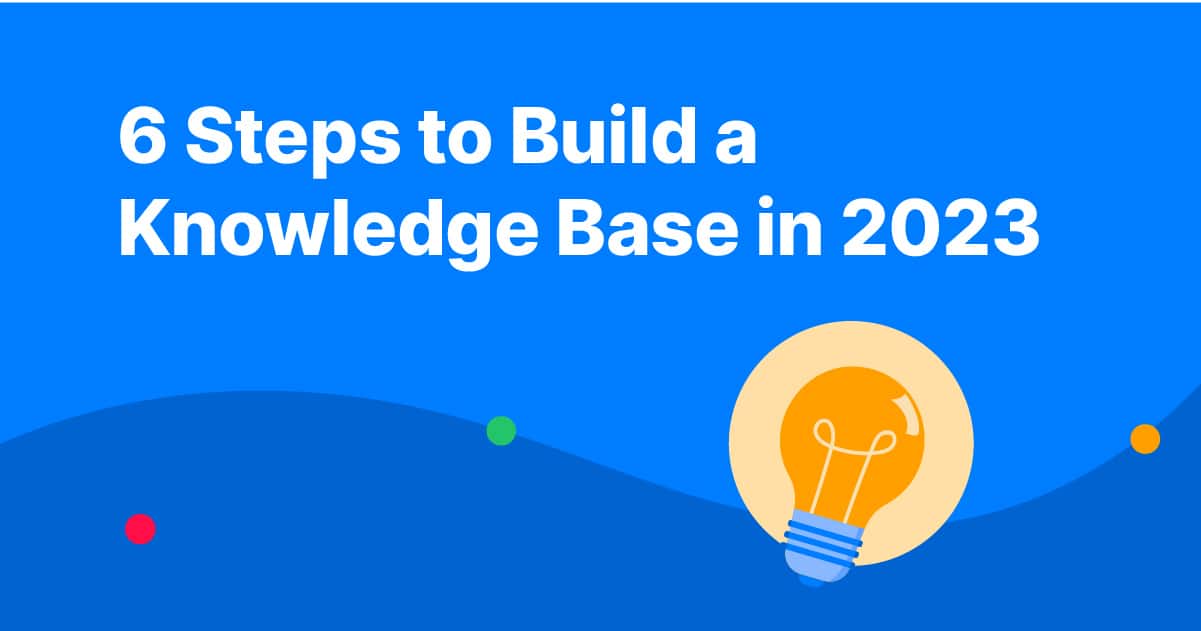Step 1: Research how to build your knowledge base
Grasping the utility of a knowledge base is one thing, but deciding on its purpose within your organization requires another level of consideration. Before constructing your knowledge base, you must determine what audience(s) you want to support: Employees? Customers? Both? After identifying their needs and researching where the most significant gaps in understanding lie, you’ll be ready for step two: setting up your thriving knowledge base.
Ask yourself these 5 questions:
- Is your response rate to employee and customer questions increasing, or is it taking longer than usual?
- What questions arise most often with both your employees and customers?
- Which department is most bombarded with requests for information on a persistent basis?
- Is productivity declining due to an inability to exchange information rapidly?
- What massive voids would be left regarding knowledge and expertise if an employee were to leave?
Answering these questions will give you an idea of whether a knowledge base is necessary and how to begin organizing it.
Step 2: Decide on the knowledge base type you need to build
Deciding that a knowledge base is necessary is only the first step. There are six popular types to choose from; consider who will utilize it most frequently, if public accessibility should be an option, and if hosting on-site or via a third-party provider makes more sense in your particular situation. Doing so will help ensure you select the ideal solution.
5 types of knowledge bases
With five different knowledge bases, selecting the right one can be intimidating. Although similarities exist among them, subtle distinctions must be considered when deciding.

Internal knowledge base
An internal knowledge base is a collection of information that is only available to people who work for your organization. A knowledge base integration with Capacity can help your team more than a traditional knowledge base because it is more organized and accessible. This knowledge base talks to your most commonly used apps, like Slack, Microsoft, and even email, to provide round-the-clock support on all organizational materials.
AI knowledge base
An AI knowledge base is an automated knowledge-management system that uses artificial intelligence to answer customer inquiries using natural language processing. By allowing customers or employees to ask questions in their own words, AI knowledge bases provide faster, more accurate responses.
AI knowledge bases also connect to your most commonly used apps and can be installed externally for your customers or internally to give accurate answers all day and night. AI knowledge bases can answer questions anytime, reducing inquiries for businesses with a high volume of queries. Like an internal or hosted knowledge base (on deck), building an AI knowledge base is best practice for 2023 and beyond, as it can deflect over 90% of queries.
Hosted knowledge base
A hosted knowledge base could be the answer if your business is looking for an effective way to store and manage its tutorials, user guides, and knowledge-base articles. This cloud-based system allows you to securely access all of this content with minimal effort on behalf of the company, thanks to third-party hosting services. Hosted knowledge bases can be both external and internal and must be very secure. As you explore building a knowledge base, ensure that your hosted knowledge base is SOC2 compliant.
Self-hosted knowledge base
Hosting a knowledge base on your servers can give you more control over security and privacy while allowing for increased uptime. However, your organization is responsible for handling any issues or concerns. This can be problematic, especially if the person who set up the knowledge base is on vacation or decides to leave the organization. Self-hosted knowledge bases require more effort to maintain but may be more cost-effective for some businesses.
Open-source knowledge base
Open-source knowledge bases are available to everyone and, in some cases, free of charge. Open-source software can be beneficial if your business requires developers to customize the source code for specific needs. Examples of such systems include OpenKM, Documize, and eXo.
No matter which knowledge base you use, ensure that it is regularly updated with the most relevant information so your team can easily access the knowledge they need. And don’t forget to include an AI chatbot in your knowledge base – it’s a great way to deflect common questions and help customers quickly find the answers they need.
With knowledge bases, it’s all a matter of finding the right fit for your organization and customers. Still, the trend for many companies is to move off outdated platforms and to an AI knowledge base as volume increases.
Step 3: Develop the structure of your knowledge base
Constructing a knowledge base structure that is both easy and efficient requires careful organization. Users can easily access information using an intuitive navigation design by creating your organizational system in the initial stages of building your knowledge base. Doing so helps you keep track of content as it grows over time and ensures users can quickly locate any material they need.

There are several different ways you can choose to organize your knowledge base:
Define your users: Effectively organizing your knowledge base based on roles and user types can give different customer groups easy access to the most relevant information. For instance, an HR-based knowledge base could include distinct sections for contractors, full-time employees, and part-time employees – creating a go-to source of help tailored just for each group.
Events and actions: If your customers are looking for a solution, an activity-based approach will make your knowledge base more accessible and valuable. For instance, say you work in the tech industry; by categorizing tutorials or articles according to product type or feature, it’ll be easier for users to find what they’re searching for without spending hours sifting through pages of irrelevant material. This organized structure ensures that time is spent getting content rather than wading thru a swamp of information.
User Confidence & Experience: When you organize your knowledge base according to the different stages of the user experience, it becomes easier for users to find the information they need.When you organize your knowledge base according to the different stages of the user experience, it becomes easier for users to find the information they need. To provide a clearer understanding, an online service’s knowledge base can be classified into sections such as initial setup help, optimizing services provided and user-friendly tutorials.
Product Feature: You can also categorize your knowledge base in terms of product features or types. For instance, tech platforms tend to be complicated due to the varying ways different users access them. As you expand and update your content, archiving and editing information will become essential – which is why providing broad categories that cover a range of topics or themes should always be considered!
Step 4: Assemble the knowledge base team
To guarantee the quality, accuracy, and efficacy of your knowledge base content for employees and clients, you’ll need a steady stream of content tailored to many different needs. Appointing subject matter experts (SMEs) to own your knowledge base, which will ultimately be responsible for crafting this information, will ensure all details within your knowledge base are correctly disseminated. Here’s what it could look like:
- The knowledge base team is responsible for creating and delivering content that meets the needs of each category. This includes outlining purpose, messaging, keywords, and calls to action on articles. They must also set deadlines and assign content development tasks to SMEs (Subject Matter Experts).
- Your knowledge base team is charged with utilizing their expertise to generate content that adheres to the guidance provided by the knowledge base manager. Additionally, this team must ensure edited material for accuracy before publication.
- Content editors should always review the content created by the knowledge base team and amend it for accuracy in spelling, grammar, style, and readability. Product teams and leaders of all levels should also be consulted to ensure that information is consistent across the organization.
- Weekly check-ins ensure content stays updated and are imperative for an excellent knowledge base. This isn’t a “set it and forget it” process. Your team should regularly perform spot checks to ensure content is accurate and up to date.
A style guide is important to ensure all your content looks the same, no matter who wrote it or edited it. This includes how words are spelled, what kind of punctuation to use, and other rules about how things should look. Using a style guide makes sure that everything looks uniform and cohesive.
Step 5: Begin writing your knowledge base
To ensure your material is simple to comprehend and your Subject Matter Experts deliver the content effectively, give them comprehensive writing guidelines that include these fundamentals:
- Be clear: Your headline should tell people what the article is about. Write in simple, straightforward language so people understand what you are talking about.
- Edit for readability: Readers like the content they can read quickly and still understand. This means that paragraphs should be short. It also means that big text blocks should be divided into smaller parts using headings, subheadings, bullets, or numbered lists.
- Make it engaging: To maximize engagement, incorporate visuals such as images, charts, infographics, or videos into your content. Alternatively – make them stand-alone pieces to draw in readers.
- Link out to resources: It is vital to link related articles within your knowledge base to provide a comprehensive answer for your readers. Connecting them to additional resources will ensure that all of their questions are answered and make it easier for them to find what they need.
- Provide value: Every single article in your knowledge base should deliver accurate answers. If engagement is low or feedback gets a 👎 it’s time to rethink your content.

Step 6: Add & Update content often
Once your knowledge base team begins to add content and users start interacting with this content, you will help have a better understanding of how to optimize to keep your knowledge base valuable and relevant. When choosing an AI-based knowledge base, you can rely on automatic user feedback to identify how and where you need to make updates, whether in your actual product or the knowledge base. Analyzing this data will provide you with the ability to:
- Know what kind of information people are looking for
- Who wrote an original knowledge-base article, and when was it last updated
- Track who is making changes and why
To ensure the Knowledge Base is up-to-date, our team must scrupulously maintain content every year. This involves modifying, refreshing, or removing material depending on alterations to company policies, products, and services that may have taken place since the initial upload of relevant data.
Choose the best knowledge base for your team
A knowledge base is an ideal way to organize information circulating within your organization to facilitate interdepartmental collaboration. Additionally, this well-maintained data resource can give customers swift access to answers they seek regarding your products and services. Capacity’s AI-powered knowledge base is easy to set up and maintain so that you can build knowledge base content quickly. With our AI chatbot, customers get more accurate answers faster, reducing the need for support staff and allowing teams to focus on more strategic initiatives.
Get started with Capacity’s AI-powered knowledge base for your team today.





